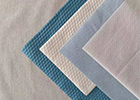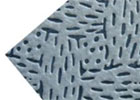Unlocking Efficiency: How to Select the Perfect Polyester Non-Woven Fabric
|
Unlocking Efficiency: How to Select the Perfect Polyester Non-Woven Fabric Polyester Non-Woven Fabric Types |
Unlocking Efficiency: How to Select the Perfect Polyester Non-Woven Fabric
Understanding the Importance of Selecting the Right Polyester Non-Woven Fabric
In various industries, such as automotive, construction, and healthcare, the choice of polyester non-woven fabric plays a crucial role in ensuring efficiency and performance. These fabrics are widely used for their durability, versatility, and cost-effectiveness. Therefore, understanding the importance of selecting the right polyester non-woven fabric is essential.
The right choice of polyester non-woven fabric can significantly impact the overall quality of the end product. It can enhance the strength and stability of the material, improve resistance to wear and tear, and provide the desired level of softness or rigidity. Additionally, the selection of the appropriate fabric can contribute to achieving specific performance requirements, such as breathability, water resistance, or flame retardancy.
Factors to Consider When Choosing Polyester Non-Woven Fabric
To ensure that you select the perfect polyester non-woven fabric for your specific application, several key factors should be considered:
1. Strength and Durability: Assess the fabric's tensile strength and abrasion resistance to ensure it can withstand the intended use and environmental conditions.
2. Weight and Thickness: Consider the weight and thickness of the fabric to match the desired level of protection and insulation without compromising flexibility or comfort.
3. Compatibility: Evaluate the fabric's compatibility with any chemicals, solvents, or processes it may encounter to avoid potential issues or degradation.
4. Cost-Effectiveness: Select a fabric that offers a balance between quality and cost-effectiveness, considering both short-term and long-term expenses.
5. Environmental Impact: Assess the fabric's environmental sustainability and recyclability to align with your company's commitment to eco-friendly practices.
6. Availability: Consider the availability and lead time of the fabric to ensure a consistent supply and avoid delays in production.
Conclusion
Selecting the perfect polyester non-woven fabric is crucial for unlocking efficiency and achieving optimal performance in various industries. By understanding the importance of this choice and considering key factors such as strength, compatibility, and cost-effectiveness, you can make an informed decision that aligns with your specific application requirements. Remember to prioritize quality, functionality, and sustainability to maximize the benefits of polyester non-woven fabrics in your business operations.

Polyester Non-Woven Fabric Types
When it comes to unlocking efficiency in industries such as automotive, construction, and healthcare, selecting the perfect polyester non-woven fabric is crucial. These fabrics are known for their durability, versatility, and cost-effectiveness, making them a popular choice. To ensure optimal performance, it is essential to understand the different types of polyester non-woven fabric available. Here, we will explore two common types: spunbond polyester non-woven fabric and meltblown polyester non-woven fabric.
Spunbond Polyester Non-Woven Fabric
Spunbond polyester non-woven fabric is created by bonding together continuous filaments of polyester fibers. This type of fabric offers excellent strength and durability, making it suitable for applications that require high-performance materials. It provides good resistance to wear and tear, withstands environmental conditions, and offers reliable protection and insulation. Spunbond polyester non-woven fabric is also known for its breathability, allowing for proper airflow and moisture management. It is commonly used in automotive interiors, filtration systems, and geotextiles.
Meltblown Polyester Non-Woven Fabric
Meltblown polyester non-woven fabric is produced by melting and extruding polyester polymer granules, which are then blown by hot air to create thin fibers. These fibers are randomly laid and bonded together, resulting in a fabric with fine filtration properties. Meltblown polyester non-woven fabric offers exceptional filtration efficiency, capturing tiny particles and contaminants. It is commonly used in medical face masks, air filters, and oil and fuel absorbent products. This type of fabric also provides excellent barrier properties, making it an ideal choice for applications that require protection against liquids or hazardous substances.
When selecting the perfect polyester non-woven fabric, there are several factors to consider. Firstly, assess the fabric's strength and durability to ensure it can withstand the intended use and environmental conditions. Consider the weight and thickness of the fabric, matching the desired level of protection without compromising flexibility or comfort. Evaluate the fabric's compatibility with any chemicals or processes it may encounter to avoid potential issues. Additionally, select a fabric that offers a balance between quality and cost-effectiveness, taking into account both short-term and long-term expenses. Assess the fabric's environmental impact and recyclability to align with your company's sustainability goals. Lastly, consider the availability and lead time of the fabric to ensure a consistent supply for your production needs.
By understanding the importance of selecting the right polyester non-woven fabric and considering these key factors, you can make an informed decision that will unlock efficiency and optimal performance in your industry. Prioritize quality, functionality, and sustainability to maximize the benefits of polyester non-woven fabrics in your business operations.

Performance Characteristics
When it comes to unlocking efficiency in industries such as automotive, construction, and healthcare, selecting the right polyester non-woven fabric is crucial. These fabrics are known for their durability, versatility, and cost-effectiveness, making them a popular choice. To ensure optimal performance, it is essential to understand the various performance characteristics of polyester non-woven fabric. Here, we will explore the strength and durability, as well as the breathability and moisture management, of polyester non-woven fabric.
Strength and Durability
Polyester non-woven fabric, particularly spunbond polyester, offers excellent strength and durability. This type of fabric is made by bonding together continuous filaments of polyester fibers, resulting in a fabric that can withstand high-performance applications. It has good resistance to wear and tear, making it suitable for demanding environments. Whether it is used in automotive interiors, filtration systems, or geotextiles, spunbond polyester non-woven fabric provides reliable protection and insulation.
Breathability and Moisture Management
One of the key advantages of polyester non-woven fabric is its breathability and moisture management capabilities. Spunbond polyester fabric allows for proper airflow, ensuring that moisture is efficiently regulated. This is crucial in applications where moisture management is necessary to maintain comfort and hygiene. Whether it is used for automotive seating, filtration systems, or medical products, polyester non-woven fabric helps to create a comfortable and dry environment.
In addition to these performance characteristics, it is important to consider several factors when selecting the perfect polyester non-woven fabric. Firstly, assess the fabric's strength and durability to ensure it can withstand the intended use and environmental conditions. Consider the weight and thickness of the fabric, matching the desired level of protection without compromising flexibility or comfort.
Evaluate the fabric's compatibility with any chemicals or processes it may encounter to avoid potential issues. Additionally, select a fabric that offers a balance between quality and cost-effectiveness, taking into account both short-term and long-term expenses. Assess the fabric's environmental impact and recyclability to align with your company's sustainability goals. Lastly, consider the availability and lead time of the fabric to ensure a consistent supply for your production needs.
By understanding the performance characteristics of polyester non-woven fabric and considering these key factors, you can make an informed decision that will unlock efficiency and optimal performance in your industry. Prioritize the strength and durability of the fabric, as well as its breathability and moisture management, to maximize the benefits of polyester non-woven fabrics in your business operations.

Application Areas
Polyester non-woven fabric is highly versatile and finds application in various industries. Here, we will explore two key areas where polyester non-woven fabric plays a crucial role: packaging and storage solutions, and hygiene and medical products.
Packaging and Storage Solutions
Polyester non-woven fabric is widely used in the packaging industry due to its excellent strength and durability. It provides reliable protection to goods during transit and storage. One of the main advantages of polyester non-woven fabric is its resistance to wear and tear, making it ideal for demanding environments. Whether it is used for wrapping delicate items, creating protective layers between components, or manufacturing durable bags and sacks, polyester non-woven fabric ensures that goods reach their destination in optimal condition. Moreover, its lightweight nature allows for efficient transportation and storage without adding unnecessary bulk.
Hygiene and Medical Products
The breathability and moisture management capabilities of polyester non-woven fabric make it highly suitable for hygiene and medical products. In applications such as adult diapers, feminine hygiene products, and medical gowns, polyester non-woven fabric helps to create a comfortable and dry environment. Its ability to regulate moisture efficiently ensures enhanced user comfort and prevents the growth of bacteria or other harmful microorganisms. The strength and durability of polyester non-woven fabric also make it ideal for use in surgical drapes, wound dressings, and medical filters. It provides reliable protection and ensures the integrity of these critical healthcare products.
When selecting the perfect polyester non-woven fabric for your specific application, there are several factors to consider. Firstly, assess the fabric's strength and durability to ensure it can withstand the intended use and environmental conditions. Consider the weight and thickness of the fabric, matching the desired level of protection without compromising flexibility or comfort. Evaluate the fabric's compatibility with any chemicals or processes it may encounter to avoid potential issues.
Additionally, select a fabric that offers a balance between quality and cost-effectiveness, taking into account both short-term and long-term expenses. Assess the fabric's environmental impact and recyclability to align with your company's sustainability goals. Lastly, consider the availability and lead time of the fabric to ensure a consistent supply for your production needs.
By understanding the application areas and considering these key factors, you can make an informed decision when selecting the perfect polyester non-woven fabric. Whether it is for packaging and storage solutions or hygiene and medical products, polyester non-woven fabric can unlock efficiency and optimal performance in your industry. Choose wisely and reap the benefits of this versatile material.

Choosing the Perfect Polyester Non-Woven Fabric
Determining the weight and thickness of polyester non-woven fabric
When selecting the perfect polyester non-woven fabric for your specific application, one of the key factors to consider is the weight and thickness of the fabric. The weight of the fabric determines its strength and durability, ensuring it can withstand the intended use and environmental conditions. It is essential to strike a balance, selecting a fabric that offers the desired level of protection without compromising flexibility or comfort.
Additionally, the thickness of the fabric plays a crucial role in its performance. Thicker fabrics provide enhanced strength and durability, making them ideal for applications that require heavy-duty protection. On the other hand, thinner fabrics offer improved flexibility and breathability, making them suitable for applications that prioritize comfort and moisture management.
Evaluating the color and aesthetic appeal of polyester non-woven fabric
The color and aesthetic appeal of polyester non-woven fabric should not be overlooked when making a selection. Depending on your industry and brand requirements, you may need to consider the visual impact of the fabric. For example, if the fabric will be used in packaging or storage solutions, you may want a fabric that aligns with your brand colors or creates a visually appealing presentation.
Furthermore, evaluating the color options available can also serve a functional purpose. For instance, certain colors may be more suitable for specific applications, such as dark colors to prevent light-sensitive products from degrading or fading.
Keep in mind that the color and aesthetic appeal of the fabric should be balanced with other important factors, such as strength, durability, and functionality. It is essential to prioritize the performance of the fabric while also considering its visual appeal.
By considering these key factors—weight and thickness, as well as color and aesthetic appeal—you can make an informed decision when selecting the perfect polyester non-woven fabric for your specific application. Whether it is for packaging and storage solutions or hygiene and medical products, choosing the right fabric will unlock efficiency and optimal performance in your industry. Take the time to assess your needs, evaluate different options, and seek guidance from fabric experts to ensure you make the best choice.

Conclusion
Selecting the right polyester non-woven fabric is crucial for unlocking efficiency in various industries. By considering factors such as weight and thickness, as well as color and aesthetic appeal, businesses can make informed decisions that align with their specific needs and requirements. The right fabric will not only provide the desired level of protection, durability, and functionality but also contribute to a visually appealing and brand-aligned presentation. Taking the time to evaluate different options and seeking guidance from fabric experts can help businesses make the best choice and unleash optimal performance in their respective industries.
Selecting the right polyester non-woven fabric for maximum efficiency
When choosing a polyester non-woven fabric for maximum efficiency, businesses need to consider various factors. The weight and thickness of the fabric play a crucial role in its performance. A balance must be struck between strength and flexibility or comfort. Selecting a fabric that offers the desired level of protection without compromising these aspects is essential. Thicker fabrics are ideal for heavy-duty applications, offering enhanced strength and durability. On the other hand, thinner fabrics provide improved flexibility and breathability, prioritizing comfort and moisture management.
Another important consideration is the color and aesthetic appeal of the fabric. Depending on the industry and branding requirements, businesses need to evaluate the visual impact of the fabric. This is particularly crucial for packaging or storage solutions, where brand alignment and visual appeal can create a positive impression. Additionally, certain color options may be more suitable for specific applications, such as using dark colors to protect light-sensitive products.
It is important to note, however, that while color and aesthetic appeal are important, they should not overshadow other important factors such as strength, durability, and functionality. The performance of the fabric should always be prioritized, ensuring that it meets the necessary requirements while also aligning with the desired visual presentation.
Key takeaways for unlocking efficiency with polyester non-woven fabric
To unlock efficiency with polyester non-woven fabric, businesses should keep the following key takeaways in mind:
1.Consider the weight and thickness of the fabric to strike a balance between strength, durability, flexibility, and comfort.
2.Evaluate the color options available to align with brand requirements and create a visually appealing presentation.
3.Ensure that the color and aesthetic appeal of the fabric do not compromise other important factors such as strength, durability, and functionality.
4.Take the time to assess specific needs and requirements, exploring different options, and seeking guidance from fabric experts to make the best choice.
By following these key takeaways, businesses can select the perfect polyester non-woven fabric for their specific applications, unlocking efficiency and optimal performance in their respective industries.





















